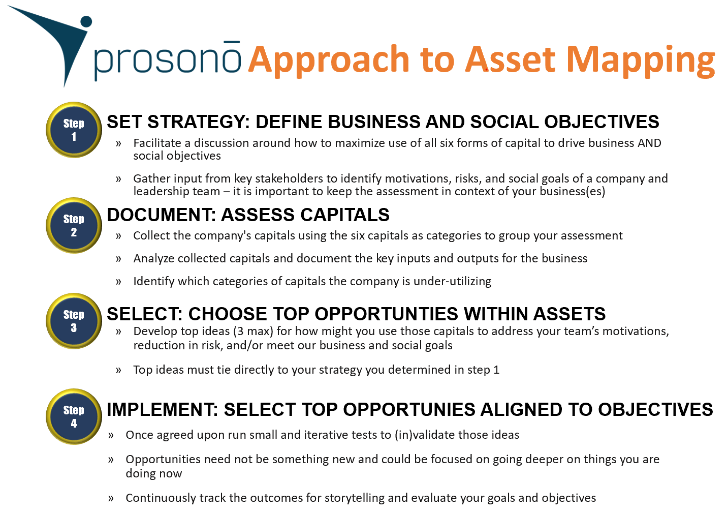5-Step Process to Asset Mapping
At a recent B.CIVIC COVID-19 response meeting, Prosono presented the simplified version of our Asset Mapping Process that has helped our clients identify and ultimately think differently about how they deploy their assets for collective impact. We define asset mapping as simply “a process to leverage the full spectrum of an organization’s products, services, resources and people towards social good”.

Step 1: Set Strategy. The most effective businesses that invest in collective social impact have a form of strategy that enables them to funnel their resources into the community for matters that are most closely tied to their business, leadership, employees, and customers’ interest. The strategy should, more importantly allow the business to say no to requests. This step includes engaging stakeholders within your business and building strong relationships with those responsible for overseeing assets. Key to this is understanding motivators, risks, pain points and considerations of each stakeholder and facilitating several sessions to narrow down and decide where business objectives meet social objectives. Setting a strategy around where business and social objectives meet will result in a new focus for your asset mapping process.
Step 2: Assess Capitals. As mentioned in our “6 Capitals’ at your disposal post there are many ways that a business should consider its ability to create community social impact. This step is the documentation of the capitals you have as a business. We find that many businesses tend to get stuck at this step and have found that thinking of their business as having capital inputs or the things that you would go out and purchase (e.g. raw materials) and having capital outputs or as a result of your company being in business what you produce. To learn more about inputs and outputs check out our post on the topic. In this step we typically uncover where some capitals are at risk, (e.g. human capital especially in poor economic times) as well as capitals that a business may have a good competitive pricing on that they could divert or deploy. Said differently, every business has assets that are sitting idle or not fully utilized at some given time that might be a good resource to deploy against advancing your social impact strategy. One example of this for illustrative purposes is a case where a business has a fleet of vehicles that normally operate during business hours and access to a trusted and certified pool of drivers. This creates the opportunity for those assets to be deployed to help pick up cancer patients and their families from the airport or hospital that would normally have to take other secure means of travel that are costly.
Step 3: Choose Top Priorities. This step is a prioritization effort that takes in to account the current realities within all the assets identified and aligns them with the strategy that was set in Step 1. We typically use a force ranking method to evaluate two priorities against one another until the top three priorities emerge. For more on how to make decisions and prioritize check out our Priority Action Framework.
Step 4: Implement. The final step is always the most challenging and daunting for organizations to take on the implementation of their strategy. The challenge with implementation in any business is the risk of their strategy failing or fear of one’s inability to execute on the top priorities. We take an iterative organizational agility approach to both strategy development and implementation. Our implementation tactics always start with designing a pilot or minimum viable product to test and learn from before deploying or exploiting the strategy. This step should help you answer how could you leverage these opportunities and who to partner with to make more collective impact. It will be important for businesses to document their journey, and the successes and failures they have along their path for purposes of continuous improvement and storytelling about the great work they are leaning into.
To read more on Asset Mapping check out our Asset Mapping overview, understanding the “6 Capitals” at your disposal, or documenting your organizations inputs and outputs posts. Click on the links to learn more or contact us at prosono@prosono.com.